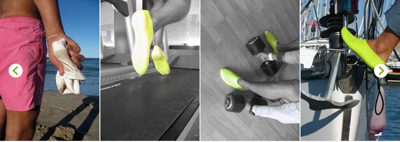There’s been a lot of talk within the ergonomics community lately about the use of the word “ergonomic” or “ergonomically designed” in product marketing claims. There’s an evolving consensus that we “need to do something,” but what exactly needs to be done to protect the public from dubious or false claims remains to be seen.
Ergonomic corn chips. Ergonomic beds and bedding. Ergonomic shoes. Ergonomic keyboards, mice, monitors, chairs, etc. Ergonomic tools. Ergonomic car interiors. Ergonomic boats. It seems there is no end to the lengths marketers will go when making claims regarding ergonomics. Some of the claims may have merit, some clearly do not.
There is a spectrum of thought within the professional ergonomics community surrounding the who, what, when, how and where of tackling the problem. On one end is:
Caveat Emptor — Let the Buyer Beware
On the other end of the spectrum is something along the lines of:
We better get busy and establish criteria for the use of ergonomics in marketing claims or both the public and our profession will be harmed.
I can see value in both options. Option 1 requires an informed public, which means we had better also improve our field’s ability to reach, educate and influence the public. Option 2 requires the various corporate entities, individuals, societies and associations involved with ergonomics to come together and find common ground, formulate guidelines and standards, and gain momentum to ‘control’ the use of ergonomics terminology in the marketplace. Neither option is easy.
Ergoweb® and Ergobuyer® have a vested interest in improving the public’s understanding of ergonomics, and we’re therefore constantly on the lookout for ergonomic claims in the marketplace, doing our best to help our customers separate fact from fiction. Lately, we’ve been keeping track of some of the examples we come across, and wanted to share a few with you to stimulate your thoughts and get your feedback on the challenges inherent in determining whether or not something is ‘ergonomic’.
Below are a few examples of some recent sightings. I want to make it clear that I’m not suggesting whether any of these products are or are not ‘ergonomic’ — they are simply examples from our recent tracking. I pose questions that came to my mind after seeing them, but we have not evaluated or reviewed them in any formal manner. You be the judge.
Tempur Pedic Ergo Adjustable Bed Bases
This advertisement has been shown extensively on television here in the USA. The company, Tempur Pedic, has a line of bed bases (bed frames) that are adjustable, going by the names Advanced Ergo Bed Base and Ergo Bed Base (there are also accessories: an Ergo Remote — a remote controller for the bed bases, and Ergo Leg Extensions).
Adjustability is a ‘good thing’ when it comes to ergonomics, but this begs the question: Does something automatically become ‘ergonomic’ simply because it is adjustable?
Here’s the ad:
[Editor’s Note: Apparently someone wasn’t happy that we featured this video in this article, and they have since disabled the ability to have it embedded here for your viewing pleasure. Instead, you now need to visit YouTube directly to see it (clicking this link will launch a new browser window): http://youtu.be/0xwj0IdmmCo.]
The Leanlever
Using a lever to gain mechanical advantage is a classic engineering technique. Take a look at this new commercial product:
LEANLEVER: A new ergonomic tool used to repeatedly lift heavy loads by leaning or just shifting your weight without stressing your back. It is even fun to use. (http://www.leanlever.com/)
The concept of leverage is very sound, but does that make this product ergonomic? As with other potential ergonomic applications, there may be some safety concerns with this, and it may have a negative affect on productivity. If that were true, would it still be ergonomic? If not, and it really did provide measurable benefits for some percentage of the population — people with severe back pain, for example — would that be ergonomic?
STRONGBACK Portable Chairs
Our chairs are the most ergonomically comfortable and healthy camping chairs available anywhere – guaranteed. (http://www.strongbackchair.com/)
These portable chairs appear to provide more lumbar support than other portable chairs. Does that make them ergonomic, or ergonomically comfortable, as they claim?
Here’s a video showing the chair features:
OneMoment: Biodegradable Shoes
Whether or not they are ergonomic, these shoes are fascinating and innovative for a number of reasons. OneMoment shoes are from Figtree Factory Studios, who claim:
A SIMPLE & BIODEGRADABLE FOOT SHELL made with HIGHTECH MATERIALS for technical applications used to make a unique and new foot gear with AN ERGONOMIC DESIGN inspired by Nature. (http://www.myfitfactory.com/PACT.html)

If something is biodegradable and ‘environmentally friendly’ does that make it ergonomic? Or is it fit that makes something ergonomic? Or is the way it functions during use that determines ergonomics? A combination of these things?
Conclusion
So, what makes something ‘ergonomic’?
Some say there is no answer to this question. Others say we can develop objective criteria to assess whether something is ergonomic. Still others say ergonomics is subjective; it’s in the eye of the beholder. And others argue that ergonomics is all about applying human-centered principles and data during the design process, but not necessarily about the outcome of that process — the product itself. Is it a comparative question, such as “tool A is more ergonomic than tool B?” Or is it an absolute question, such as “Tool A is ergonomic, but Tool B is not?”
What do you think?
This article was last modified April 8, 2001.
